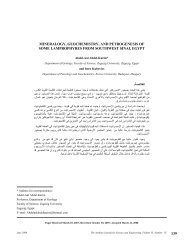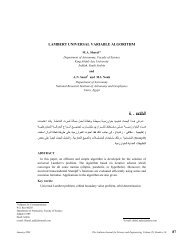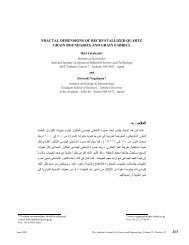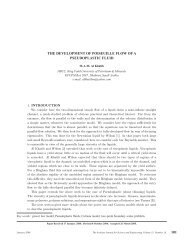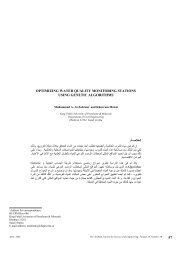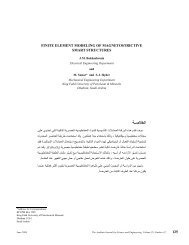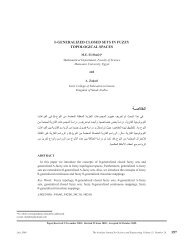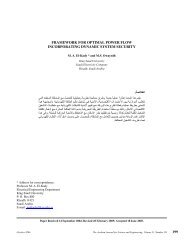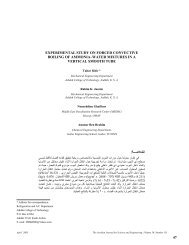HYDRODESULFURIZATION OF THIOPHENE OVER BIMETALLIC ...
HYDRODESULFURIZATION OF THIOPHENE OVER BIMETALLIC ...
HYDRODESULFURIZATION OF THIOPHENE OVER BIMETALLIC ...
Create successful ePaper yourself
Turn your PDF publications into a flip-book with our unique Google optimized e-Paper software.
56<br />
Hamid A. Al-Megren<br />
<strong>HYDRODESULFURIZATION</strong> <strong>OF</strong> <strong>THIOPHENE</strong> <strong>OVER</strong> <strong>BIMETALLIC</strong> Ni–Mo SULFIDE<br />
CATALYSTS PREPARED BY DIFFERENT METHODS<br />
1. INTRODUCTION<br />
At present, the hydrodesulfurization (HDS) process is an efficient method for sulfur removal from gasoline and<br />
diesel of high sulfur content [1,2]. In the HDS process, organic sulfur compounds in the liquid fuels are broken<br />
down to H2S using NiMo–CoMo/Al2O3 catalysts [3–6], followed by the removal of H2S, and the sulfur content in<br />
fuels can be reduced to about 10 ppm. Sulfided Ni–Mo catalysts are widely used in hydrotreating reactions [7,8].<br />
Several studies have shown that monometallic cobalt catalyst are active for hydrodesulfurization (HDS) reactions<br />
[9–11]. For example, Duchet et al. investigated carbon supported molybdenum and tungsten catalysts for HDS of<br />
thiophenes [12]. In some cases, however, their HDS activities are low and unimportant due to a low degree of cobalt<br />
dispersion and/or strong interactions with some support materials like alumina [13]. Therefore it is of great interest<br />
to examine the influence of the preparation method on the properties and activity of the catalyst, as well as on the<br />
interaction between promoters and supports [14]. In the present investigations, emphasis was focused on studying<br />
the effect of the preparation method on the hydrodesulfurization activity of Ni–Mo catalysts.<br />
To improve the performance of the HDS catalyst, all steps in the preparation procedure should be considered.<br />
The key parameters are the choice of a precursor of the active species, support, synthesis, and post-treatment of the<br />
synthesized catalyst. The nature of the active phase can be modified by changing the amount of active component<br />
[15], and by the introduction of additives. Numerous additives have been studied, and phosphorus [16, 17] and<br />
fluorine [18–21] have received special attention. In some studies, the sulfides of transition metals were replaced by<br />
nitrides [22] or carbides [23, 24]. Noble metals are also used as the active phase in hydrotreating catalysts for second<br />
stage HDS [25].<br />
Various supports have been used to enhance the catalytic activity in HDS: carbon [26–28], silica [29, 30],<br />
zeolites [31–34], titania and zirconia [35–37], and silica–alumina [38, 39]. Combining new types of catalytic species<br />
with advanced catalyst supports such as ASA (amorphous silica–alumina) can result in an extremely high<br />
desulfurization performance. The application of ASA-supported noble metal-based catalysts for the second-stage<br />
deep desulfurization of gas oil is an example [25]. The Pt and Pt–Pd catalysts are very active in the deep HDS of prehydrotreated<br />
straight run gas oil under industrial conditions. These catalysts are able to reduce the sulfur content to 6<br />
ppm, while simultaneously reducing the aromatics to 75% of their initial amount. At high sulfur levels, the ASA<br />
supported noble metal catalysts are poisoned by sulfur and Ni–W–ASA catalysts become preferable for deep HDS<br />
and dearomatization.<br />
It has long been recognized that the optimal performance of a catalyst depends on its preparation method [40].<br />
The common preparation methods require a combination of different unit operations. Some of these are not entirely<br />
understood. They can be described as: (i) introduction of the metal precursor on the support by impregnation or ionexchange<br />
[41], co-precipitation and deposition precipitation [42]; (ii) drying and calcination, and (iii) reduction. The<br />
size and distribution of metal crystallites in the support, the homogeneity of the multi-component catalyst, the<br />
porosity, surface area, and pore size distribution are all functions of the precursors used in the preparation. Some<br />
preparation parameters such as temperature of treatment, pH of the solution and the aqueous or organic medium also<br />
contribute to the catalyst preparation. Recently, significant progress has been made towards understanding the<br />
relationship between the preparation method and final properties of the catalyst and supports [41]. Generally, it is<br />
believed that the catalyst selectivity depends on the particle size of the dispersed metal and spatial distribution of the<br />
active component in the porous support. The stability of the catalyst depends on the interaction of the metal and the<br />
supports.<br />
The controlled preparation of heterogeneous catalysts has been studied for more than 100 years [42]. However,<br />
perfectly designed catalysts still remain a challenge. Impregnation, sol–gel, ion-exchange, precipitation, and<br />
deposition-precipitation are the commonly used methods [43].<br />
The impregnation method requires the support to be contacted with a certain amount of solution of a metal<br />
precursor, usually a salt, and then it is aged, usually for a short time, dried, and calcined [41]. This method appears to<br />
be simple, and economical (especially when using solutions of costly active components), and able to yield a<br />
reproducible catalyst. However, when drying, the dissolved metal compounds often crystallize in the support, which<br />
leads to larger crystallites and thus leading to low metal dispersion.<br />
The ion–exchange method consists of exchanging either hydroxyl groups or protons from the supports, with<br />
cations and anions in the solutions [41]. In this method, it is important to adjust the pH values to control the<br />
interaction between the support and metal precursors. A knowledge of the isoelectric point is essential if meaningful<br />
dispersions are to be obtained.<br />
January 2009 The Arabian Journal for Science and Engineering, Volume 34, Number 1A



